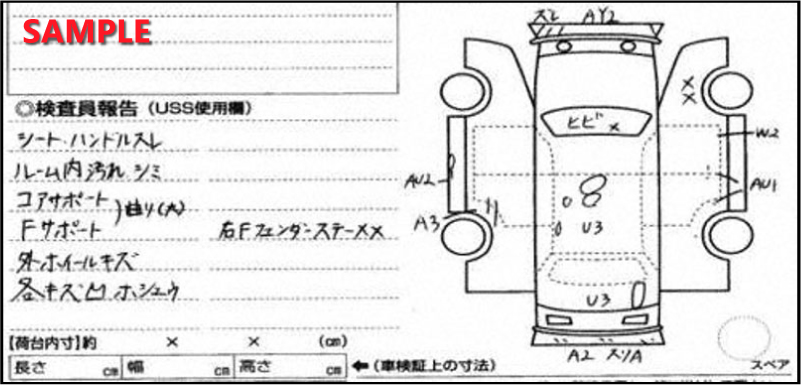- Get a quotation
Make an inquiry via Whatsapp. - Pay deposit
Transfer us the higher of $800 or 20% of the total amount. - Auction
We will send you pictures and auction sheet with English translation. We bid the car if you like. - Full payment
Congrats! we won the auction. Pay the balance within 5 days. - Receive your car
We arrange shipment after payment confirmation.
Japanese Used Car Auction
Simple five steps to buy your car from auction
How to read auction sheet
A Lot number
B Displacement (cc)
C Model code
D First registration year/month
E Name of the model
F Package
G Mileage (km)
H Transmission (AT/MT)
I Aircon
J Exterior color
K Fuel type
L Standard features
M Sales points
N Chassis code / VIN code
[1] Overall grade
6 New
5 As new with no condition faults
4.5 Very clean, one panel affected by minor paint blemish
4 More than one panel affected by minor paint blemishes
3.5 Some attention to panel and paint is required
3 Rough overall condition
2 Serious panel damage, rusty or water damaged
1 Significant performance upgrades or mechanical changes
A, 0, R Accident damage and repair
[2] Vehicle diagram
XX Panels have been replaced due to repairs and / or painted.
W Wavy...Can mean the affected panel has been painted, and the paint is not as smooth as the original factory paint.
A Scratch
A1 is a tiny scratch, and generally you would expect this to buff out or be an easy touch up.
A2 is a medium scratch through the top layer of paint, and won’t easily be hidden.
A3 is a deep scratch such as a serious scrape or intentional key mark, and will definitely require paintwork if you want to fully address it.
U Pin dent
U1 to U4 are used to denote the size of the dent, with 1 being the smallest.
B Dent and scratch
These are more serious than pin dents. They are quite noticeable dents and range from B1 to B4.
G Chip
You might see a G, X on the windscreen. This usually indicates a small stone chip or scratch.
Y Cracks
Y1 to Y4. Usually in bodykits or lights and often not a major issue as repair or replacement is fairly simple.
P Paint damage
P1 to P4. Fading, scratches or discoloration from sun damage, polishing, peeling, crazing or poor paintwork.
S / C Rust / Corrosion
S and C1 to C4 are generally used. An S or C1 on the body can mean a small stone chip has some surface rust or there is a spot of rust on the edge of a sunroof which might be easily addressed. In other cases S noted in the negative comments section could indicate extensive underbody rust. C indicated on the wheel arches is a sign there is serious corrosion due to use in snowy areas.
[3] Negative comments box by inspector
It is often overlooked, but very important to check this part. Engine noise or oil leaks, and major faults will be noted here.

